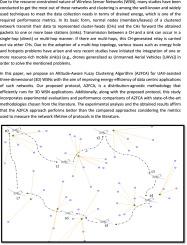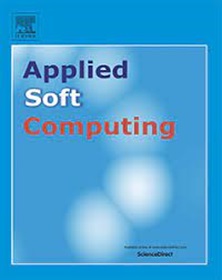An altitude-aware fuzzy approach for energy efficiency in UAV-assisted 3D Wireless Sensor Networks
IF 7.2
1区 计算机科学
Q1 COMPUTER SCIENCE, ARTIFICIAL INTELLIGENCE
引用次数: 0
Abstract
In Wireless Sensor Networks (WSNs) that use multi-hop topologies, issues like energy holes and hotspots have become prominent. To address these, recent research has proposed using mobile sinks with abundant resources. These include mobile robots, drones, and notably, Unmanned Aerial Vehicles (UAVs), as solutions to alleviate these challenges. This paper introduces a novel altitude-aware fuzzy approach aimed at improving energy efficiency in UAV-supported 3D WSNs. The proposed methodology comprises two key components. Firstly, a tailored fuzzy clustering algorithm is developed to manage the spatial structure of the 3D WSN, optimizing energy consumption. Secondly, a hybrid grey wolf optimization algorithm is utilized to fine-tune the parameters of the fuzzy clustering algorithm, ensuring optimal performance. The synergistic and seamless integration of these components addresses the energy efficiency challenges inherent in UAV-assisted 3D WSNs. The significance of this approach lies in its capacity to navigate the escalating complexity and energy demands of modern sensor networks, offering a harmonious blend of theoretical innovation and practical applicability. Experimental analysis and results substantiate the superior performance of the proposed approach compared to existing solutions, as measured by the metrics commonly employed to evaluate the network lifetime of protocols in the literature.

无人机辅助 3D 无线传感器网络中提高能效的高度感知模糊方法
在使用多跳拓扑结构的无线传感器网络(WSN)中,能量漏洞和热点等问题变得十分突出。为了解决这些问题,最近的研究提出使用资源丰富的移动汇。其中包括移动机器人、无人机,尤其是无人机(UAV),作为缓解这些挑战的解决方案。本文介绍了一种新颖的高度感知模糊方法,旨在提高无人机支持的 3D WSN 的能效。所提出的方法包括两个关键部分。首先,开发了一种量身定制的模糊聚类算法,用于管理 3D WSN 的空间结构,优化能耗。其次,利用混合灰狼优化算法对模糊聚类算法的参数进行微调,确保最佳性能。这些组件的协同和无缝集成解决了无人机辅助三维 WSN 所固有的能效挑战。这种方法的意义在于,它能够驾驭现代传感器网络不断升级的复杂性和能源需求,将理论创新与实际应用性和谐地融为一体。实验分析和结果证明,与现有的解决方案相比,所提出的方法具有更优越的性能,这可以用文献中常用来评估协议网络寿命的指标来衡量。
本文章由计算机程序翻译,如有差异,请以英文原文为准。
求助全文
约1分钟内获得全文
求助全文
来源期刊

Applied Soft Computing
工程技术-计算机:跨学科应用
CiteScore
15.80
自引率
6.90%
发文量
874
审稿时长
10.9 months
期刊介绍:
Applied Soft Computing is an international journal promoting an integrated view of soft computing to solve real life problems.The focus is to publish the highest quality research in application and convergence of the areas of Fuzzy Logic, Neural Networks, Evolutionary Computing, Rough Sets and other similar techniques to address real world complexities.
Applied Soft Computing is a rolling publication: articles are published as soon as the editor-in-chief has accepted them. Therefore, the web site will continuously be updated with new articles and the publication time will be short.
 求助内容:
求助内容: 应助结果提醒方式:
应助结果提醒方式:


